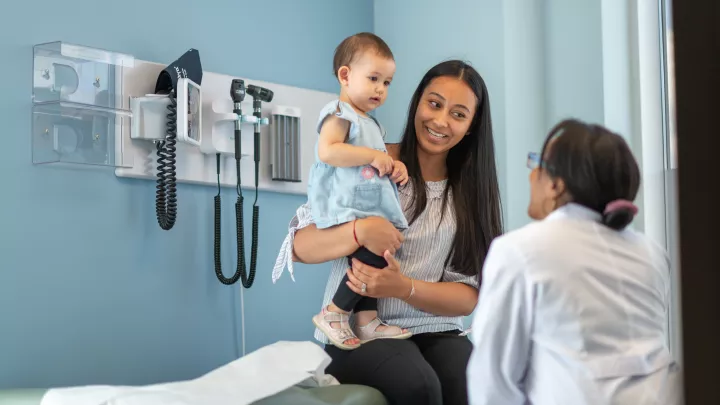
Genome Sequencing Finds Answers to Mystery Conditions in the NICCU
When a critically ill infant is admitted to the Steven & Alexandra Cohen Foundation Newborn and Infant Critical Care Unit (NICCU) at Children’s Hospital Los Angeles, it can be for an underlying genetic cause for the baby’s symptoms. The hard part is locating the malfunction in the genes involved. To help with this process—and better tailor a baby's treatment—CHLA is now providing genome sequencing for infants who present with complex and rare conditions.
"Many patients have clinical findings that are likely genetic but cannot be easily diagnosed using one-gene-at-a-time strategies," explains Matthew Deardorff, MD, PhD, Director of Translational Genomics at the Center for Personalized Medicine at CHLA. "Rather than testing a few genes, we are now sequencing all genes at once and then analyzing the data to find a specific diagnosis."
Genetic causes of mystery conditions
Genetic sequencing has become amazingly cheaper and faster over the years. The first human genome sequenced in 2003 by the NIH Human Genome Project took 13 years and cost $2.7 billion. “Our process costs under $1,000 to generate data for an individual,” Dr. Deardorff notes.

“When you sequence a whole genome, it generates 6 billion pieces or ‘letters’ of information and maybe 99.9% of those are the same between all of us,” he adds. “But 0.1% of 6 billion is still a huge number—and finding an answer in all those genetic variants can be challenging.”
Many of these genetic variants are common. To hunt for explanations for rare and complex conditions, the Center for Personalized Medicine focuses primarily on rare variants. The Center employs a leading-edge technology—whole genome sequencing (WGS)—to analyze all the DNA in a genome, including chromosomal and mitochondrial DNA. WGS creates a detailed map of an individual’s complete DNA, making it easier to pinpoint changes in the genome that could cause disease or disability. “This ability to generate the sequence data for all of the genes at once and then use powerful informatics tools to sift through the data helps us to more quickly find a specific diagnosis,” Dr. Deardorff explained.
Evolution of genomic sequencing in the NICCU
Previous versions of genome sequencing (exome sequencing) contained ~2% of the data in WGS and could take more than a year to get results. "With today’s sequencing technologies and the workflows in place at CHLA, we can obtain results from WGS quickly, often in less than a week for babies in the NICCU,” Dr. Deardorff says.
The team has ambitious plans to incorporate those gene variants into managing the care of babies in the NICCU. “Some of those variants influence how you break down certain medications, or how many doses of medication you might need, or if you are at risk for side effects from a particular medication,” Dr. Deardorff explained.
Earlier studies found that using WGS in the NICCU could reduce medical costs and unnecessary procedures, shorten hospital stays, and improve outcomes for babies and their families. “These studies found that using WGS empowers doctors to diagnose rare diseases more quickly, and 50% of kids in the NICCU ended up with a genetic diagnosis,” Dr. Deardorff says. “At CHLA, we’ve started to use WGS for a broader population. As a result, we’re diagnosing more kids now and starting treatment earlier—and we can also spot potential problems earlier.”
Applying WGS insights clinically
Dr. Deardorff’s team works closely with CHLA’s NICCU in the Fetal and Neonatal Institute, as well as with the genetic counseling team, introducing testing early in the admission process to give the lab more time to analyze the data. Once a specific genetic diagnosis is identified, treatment can be individualized.
For example, recently, a baby came to CHLA with a hand anomaly and difficulty feeding. Using WGS, a diagnosis of CHARGE syndrome was made. Although this syndrome is rare, features of CHARGE, such as abnormalities with the eyes, heart, arms, kidneys, and facial movement, are well known. But not all children have all the features. “Knowing the diagnosis prompted us to look carefully at the kidneys and eyes to ensure no problems existed for this baby,” Dr. Deardorff says.
In addition to the exceedingly rare variants identified in the process of diagnosing infants in the NICCU, WGS data contains variants that are more common, but can be used to inform treatment. The CHLA team has ambitious plans to incorporate those gene variants into managing the care of babies in the NICCU, as well as for children in other parts of the hospital and outpatient settings. “Some of these common variants influence how you break down certain medications, or how many doses of medication you might need, or if you are at risk for side effects from a particular medication,” Dr. Deardorff says. “Our team at CHLA is embracing this knowledge—called pharmacogenomics—for its ability to improve pediatric care.”
Variants of unknown significance
One major challenge of using WGS for clinical diagnosis is distinguishing a problematic genetic variant from the vast number of differences that are merely normal person-to-person variation. To improve the diagnosis of children with rare disorders, the Center for Personalized Medicine tests parents alongside the child, called a trio study. Sometimes a child has inherited two copies of a specific gene from their parents. While a single copy of the gene doesn’t affect the parents, two copies cause a recessive disorder in the child. It is also possible for a child to be born with a new, spontaneous genetic change or mutation that neither parent carries.
To complement the expertise of CHLA’s clinical teams and laboratory directors, the Center for Personalized Medicine is also incorporating artificial intelligence to find answers faster, in addition to working to filter out irrelevant variants.
WGS can also identify potential completely novel answers. “Sometimes we see a variant that's just so striking that it should be related, and maybe it's new in the child, but we just don't know anything about the gene,” Dr. Deardorff says. “We then reach out to colleagues around the globe to find out if they have seen anything that looks like it. The information we aggregate from kids in other parts of the world helps us better understand the children here at CHLA.”
Below are some terms you may hear when discussing genetic testing in a medical setting:
- Genome—the complete set of genetic information of an individual
- Personalized medicine—tailoring treatment to an individual’s particular genetic makeup
- Phenotype—the characteristics of how gene and environmental interactions appear in an individual that can be observed
- Whole genome sequencing (WGS)—sequences all the genetic material of an individual
- De novo—new
- Gene variant—a permanent change or alteration in the DNA sequence of a gene
- Variant of unknown significance—nobody knows what this gene variant does


